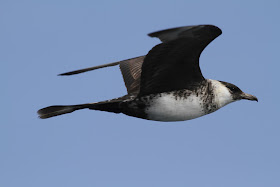Ordinarily mid-May sees spring migration begin to slow but
with northerly winds dominating the early part of the spring, several species
seem to have been held-up, and the last few days have seen hirundines on the
move, mostly House Martins but also
smaller numbers of Swallows and Sand Martins too. Early indications
from the BTO House Martin survey suggest that it is a slow start to their
breeding season; perhaps there are still birds that haven’t arrived back yet.
There will still be plenty of birds on the move and, for some, now is the time to catch up with them. Arctic
Terns will peak in the next week or so, mainly moving up the west coast but
also through the Severn and Trent valleys, as some of them make their way into
the North Sea. This is also a good time to look out for Long-tailed Skuas, with the very best site being Aird an Runair,
the most westerly point of the island of Uist in the Western Isles.
 |
| Arctic Terns by Jamie MacArthur |
Nightjars
typically arrive back on their breeding territories around mid-May and migrants
birds can be found almost anywhere, and if you stand any chance of seeing Golden Oriole in Britain, now is the
time.
May is the month that Honey
Buzzard arrive back and in the right weather conditions, move through the country.
South-easterlies are what is needed, and if we do get winds from this direction
in the next couple of weeks it could get exciting, with Red-spotted Bluethroats, Wrynecks, Red-backed Shrikes and Icterine Warblers turning up.
 |
| Red-spotted Bluethroat by Edmund Fellowes |
The weather over the weekend is due to turn southerly for a
short time with a hint of south-easterly early next week, whether or not this
will be strong enough, or come from far enough east to turn up eastern bound
migrants will have to be seen but it will be a change from the westerlies of
the last week or so and a change in wind direction quite often turns birds up
and allows others to move.
At this time of the year anything can turn up, as evidenced
by the Great Reed Warbler that was
found in a tiny reedbed on the BTO’s Nunnery Lakes reserve in Norfolk, the
first for the site. It would be fantastic if it was followed up with a Crag Martin next week.
 |
| Great Reed Warbler by Mike Symes |


